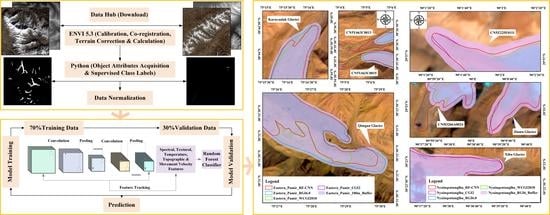Novel Machine Learning Method Integrating Ensemble Learning and Deep Learning for Mapping Debris-Covered Glaciers
Abstract
:1. Introduction
2. Research Area and Data Sources
2.1. Research Area
2.2. Dataset Acquisition and Pre-Processing
- (1)
- Perform radiometric and atmospheric correction on the spectral data of Landsat 8 images.
- (2)
- The band calculation tool of the ENVI software is used to normalize the data of each band, and the normalized difference vegetation index (NDVI) [61,62], normalized difference water index (NDWI) [63,64], and normalized difference snow index (NDSI) [26,65] are calculated. It also identifies the coastal/aerosol, red, green, and blue bands, along with the near-infrared (NIR) and mid-infrared (SWIR-1 and SWIR-2) bands. The texture features (mean) [11] based on spectral data are then calculated by the statistical method of the grey-scale co-occurrence matrix (GLCM) proposed in the early 1970s by R. Haralick et al. [66]. Temperature characteristics (LST) are automatically obtained by identifying image metadata information through the surface temperature inversion tool of the ENVI software and obtaining atmospheric profile parameters. The glacier movement data are obtained by tracking the displacement of the glacier surface features between the two phases of Landsat 8 images based on the image cross-correlation method of frequency domain transformation in the COSI-Corr software package [67]. The calculation of terrain features is based on DEM data to obtain the elevation, slope, aspect, and shaded relief. The above feature data (spectral features + textural features + temperature features + topographic features + movement velocity features) are separately output as a grayscale image, which results in 23 grayscale images.
- (3)
- Load the 23 grayscale images and create a new debris-covered glacier vector file according to the visual interpretation method based on 23 grayscale images showing the extent of glaciers through ArcGIS software. The processed glacier vector file is binarized to finally obtain a label file of the remote sensing image glacier distribution.
- (4)
- Utilize the OpenCV-Python library function in Python to read the 23 processed grayscale images and corresponding label files, and use the sliding window to crop the images; use the ‘imgaug’ library function to obtain the expanded dataset of all the cropped images according to the data enhancement method by operations such as panning and flipping; finally, through linear mapping of each dimensional feature into the target range [−1, 1], the normalized dataset is obtained, and all the normalized images are divided to obtain a training set, a validation set, and a test set.
2.3. Input Feature Analysis for Classification
3. Methodology
3.1. Random Forest Classification
- (1)
- Decompose the input Landsat 8 images and DEM data; extract the data’s spectral features, index features, texture features, temperature features, topographic features, and glacier movement speed features to obtain a 24-dimensional data set.
- (2)
- Randomly scramble the data set and construct attribute sets separately. Select 70% of the samples as the labeled sample set, and the rest are unlabeled sample sets. Use the same loss function for the unlabeled and labeled samples to build the initial RF model.
- (3)
- Initialize the number of training iterations, select a certain number of label samples to train the classifier, take all the unlabeled samples with high confidence values, and give each label a value. Then, add it to the label set and update the label sample set. The latter label sample set is used as the training set for the semi-supervised training of the RF model to obtain a new RF model.
- (4)
- By introducing unlabeled data and adding all unlabeled sample data to the optimization goal, the initial value of the data misclassification rate of the overall model is given to control the optimization. When the misclassification rate of the entire out-of-bag data set is zero, the optimal RF model is obtained.
- (5)
- According to the category label matrix, each pixel of the glacier data based on remote sensing images and digital elevation models is classified; the classified image is output, and the classification accuracy rate is calculated.
3.2. Convolutional Neural Network Classification
- (1)
- Use the ‘TensorFlow’ and ‘Keras’ packages in Python to build a CNN framework to construct a remote sensing image glacier segmentation model based on deep learning [73,74]. The glacier segmentation model based on remote sensing images has 24 inputs as training samples, including 23 grayscale images and 1 corresponding label file.
- (2)
- According to the calculation performance of the computer’s graphics card and the number of model parameters, set the training batch size = 128 and learning rate = 0.001, use the training function and the training set to iteratively train the remote sensing image glacier segmentation model, and use the validation set and test set to verify and test the remote sensing image glacier segmentation model after each round of training, respectively. When the remote sensing image glacier segmentation model converges, save the trained remote sensing image glacier segmentation model.
- (3)
- After outputting the segmentation results of the trained remote sensing image glacier segmentation model, the segmentation results are fine-tuned using the guided filter (GF) [75] and conditional random field (CRF) model [76]. Among them, GF uses the label file as a guide map, and uses the original image as the input image to optimize the boundary of the glacier extraction results to eliminate salt-and-pepper noise. The binary potential function in the CRF constrains the color and position between any two pixels, making it easier for pixels with similar colors and adjacent positions to have the same classification. Further, edges are smoothed according to the smoothness between adjacent pixels.
3.3. RF–CNN Classification
- (1)
- Create a training dataset for the study area, and use samples and sample labels as the training data set;
- (2)
- First, establish a CNN model; then, use the samples and sample labels in step (1) to train the model, and save the model for later use;
- (3)
- Use the CNN model in step (2) to extract the feature layers of the study area—that is, extract the deep features;
- (4)
- Extract the shallow features of Landsat 8 images and DEM in the study area, including spectral features, index features, texture features, temperature features, topographic features, and glacier movement speed features;
- (5)
- Perform multi-feature combination for the deep features extracted in step (3) and the shallow features extracted in step (4);
- (6)
- Use RFs to perform semantic segmentation on the combined features in step (5) to achieve glacier segmentation based on remote sensing images.
3.4. Selection of Classification Metrics
4. Results
5. Discussion
5.1. Comparison with Existing Methods and Inventories
5.2. Feature Analysis
5.3. Limitations
6. Conclusions
Author Contributions
Funding
Institutional Review Board Statement
Informed Consent Statement
Data Availability Statement
Acknowledgments
Conflicts of Interest
References
- Paul, F.; Bolch, T.; Kääb, A.; Nagler, T.; Nuth, C.; Scharrer, K.; Shepherd, A.; Strozzi, T.; Ticconi, F.; Bhambri, R.; et al. The Glaciers Climate Change Initiative: Methods for Creating Glacier Area, Elevation Change and Velocity Products. Remote Sens. Environ. 2015, 162, 408–426. [Google Scholar] [CrossRef] [Green Version]
- Zhou, Z.; Han, N.; Liu, J.; Yan, Z.; Xu, C.; Cai, J.; Shang, Y.; Zhu, J. Glacier Variations and Their Response to Climate Change in an Arid Inland River Basin of Northwest China. J. Arid Land 2020, 12, 357–373. [Google Scholar] [CrossRef]
- Ye, Q.; Zong, J.; Tian, L.; Cogley, J.G.; Song, C.; Guo, W. Glacier Changes on the Tibetan Plateau Derived from Landsat Imagery: Mid-1970s–2000–13. J. Glaciol. 2017, 63, 273–287. [Google Scholar] [CrossRef] [Green Version]
- Blöthe, J.H.; Halla, C.; Schwalbe, E.; Bottegal, E.; Trombotto Liaudat, D.; Schrott, L. Surface Velocity Fields of Active Rock Glaciers and Ice-debris Complexes in the Central Andes of Argentina. Earth Surf. Process. Landf. 2021, 46, 504–522. [Google Scholar] [CrossRef]
- Zhao, Q.; Ding, Y.; Wang, J.; Gao, H.; Zhang, S.; Zhao, C.; Xu, J.; Han, H.; Shangguan, D. Projecting Climate Change Impacts on Hydrological Processes on the Tibetan Plateau with Model Calibration against the Glacier Inventory Data and Observed Streamflow. J. Hydrol. 2019, 573, 60–81. [Google Scholar] [CrossRef]
- Regine, H.; Rasul, G.; Adler, C.; Cáceres, B.; Gruber, S.; Hirabayashi, Y.; Jackson, M. High Mountain Areas. In IPCC Special Report on the Ocean and Cryosphere in a Changing Climate; IPCC: Geneva, Switzerland, 2019. [Google Scholar]
- Immerzeel, W.W.; Van Beek, L.P.; Bierkens, M.F. Climate Change Will Affect the Asian Water Towers. Science 2010, 328, 1382–1385. [Google Scholar] [CrossRef] [PubMed]
- Immerzeel, W.W.; Lutz, A.F.; Andrade, M.; Bahl, A.; Biemans, H.; Bolch, T.; Hyde, S.; Brumby, S.; Davies, B.J.; Elmore, A.C.; et al. Importance and Vulnerability of the World’s Water Towers. Nature 2020, 577, 364–369. [Google Scholar] [CrossRef]
- Nie, Y.; Pritchard, H.D.; Liu, Q.; Hennig, T.; Wang, W.; Wang, X.; Liu, S.; Nepal, S.; Samyn, D.; Hewitt, K.; et al. Glacial Change and Hydrological Implications in the Himalaya and Karakoram. Nat. Rev. Earth Environ. 2021, 2, 91–106. [Google Scholar] [CrossRef]
- Liu, S.; Wu, T.; Wang, X.; Wu, X.; Yao, X.; Liu, Q.; Zhang, Y.; Wei, J.; Zhu, X. Changes in the Global Cryosphere and Their Impacts: A Review and New Perspective. Sci. Cold Arid. Reg. 2020, 12, 343–354. [Google Scholar] [CrossRef]
- Lu, Y.; Zhang, Z.; Huang, D. Glacier Mapping Based on Random Forest Algorithm: A Case Study over the Eastern Pamir. Water 2020, 12, 3231. [Google Scholar] [CrossRef]
- Liu, S.; Yao, X.; Guo, W.; Xu, J.; Shangguan, D.; Wei, J.; Bao, W.; Wu, L. The contemporary glaciers in China based on the Second Chinese Glacier Inventory. Acta Geogr. Sin. 2015, 70, 3–16. [Google Scholar] [CrossRef]
- Zhao, L.; Ding, R.; Moore, J.C. Glacier Volume and Area Change by 2050 in High Mountain Asia. Glob. Planet. Chang. 2014, 122, 197–207. [Google Scholar] [CrossRef]
- Zhang, Z.; Liu, S.; Jiang, Z.; Shangguan, D.; Wei, J.; Guo, W.; Xu, J.; Zhang, Y.; Zhang, S.; Huang, D. Glacier Variations at Xinqingfeng and Malan Ice Caps in the Inner Tibetan Plateau Since 1970. Remote Sens. 2020, 12, 421. [Google Scholar] [CrossRef] [Green Version]
- Brun, F.; Wagnon, P.; Berthier, E.; Jomelli, V.; Maharjan, S.B.; Shrestha, F.; Kraaijenbrink, P.D.A. Heterogeneous Influence of Glacier Morphology on the Mass Balance Variability in High Mountain Asia. J. Geophys. Res. Earth 2019, 124, 1331–1345. [Google Scholar] [CrossRef]
- Huo, D.; Chi, Z.; Ma, A. Modeling Surface Processes on Debris-Covered Glaciers: A Review with Reference to the High Mountain Asia. Water 2021, 13, 101. [Google Scholar] [CrossRef]
- Miles, K.E. Hydrology of Debris-Covered Glaciers in High Mountain Asia. Earth Sci. Rev. 2020, 207, 103212. [Google Scholar] [CrossRef]
- Wu, K.; Liu, S.; Xu, J.; Zhu, Y.; Liu, Q.; Jiang, Z.; Wei, J. Spatiotemporal Variability of Surface Velocities of Monsoon Temperate Glaciers in the Kangri Karpo Mountains, Southeastern Tibetan Plateau. J. Glaciol. 2021, 67, 186–191. [Google Scholar] [CrossRef]
- Buchroithner, M.F.; Bolch, T. An Automated Method to Delineate the Ice Extension of the Debris-Covered Glaciers at Mt. Everest Based on ASTER Imagery. In Proceedings of the 9th International Symposium on High Mountain Remote Sensing Cartography, Graz, Austria, 14–22 September 2006. [Google Scholar]
- Biddle, D. Mapping Debris-Covered Glaciers in the Cordillera Blanca, Peru: An Object-Based Image Analysis Approach. Master’s Thesis, University of Louisville, Louisville, KY, USA, 2015. [Google Scholar]
- Racoviteanu, A.E.; Nicholson, L.; Glasser, N.F. Surface Composition of Debris-Covered Glaciers across the Himalaya Using Spectral Unmixing and Multi-Sensor Imagery. Cryosphere Discuss. 2021, 1–48. [Google Scholar] [CrossRef]
- Fleischer, F.; Otto, J.; Junker, R.R.; Hölbling, D. Evolution of Debris Cover on Glaciers of the Eastern Alps, Austria, between 1996 and 2015. Earth Surf. Process. Landf. 2021, esp.5065. [Google Scholar] [CrossRef]
- Xie, F.; Liu, S.; Wu, K.; Zhu, Y.; Gao, Y.; Qi, M.; Duan, S.; Saifullah, M.; Tahir, A.A. Upward Expansion of Supra-Glacial Debris Cover in the Hunza Valley, Karakoram, During 1990∼2019. Front. Earth Sci. 2020, 8, 308. [Google Scholar] [CrossRef]
- Robson, B.A.; Bolch, T.; MacDonell, S.; Hölbling, D.; Rastner, P.; Schaffer, N. Automated Detection of Rock Glaciers Using Deep Learning and Object-Based Image Analysis. Remote Sens. Environ. 2020, 250, 112033. [Google Scholar] [CrossRef]
- Zhang, J.; Li, J.; Menenti, M.; Hu, G. Glacier Facies Mapping Using a Machine-Learning Algorithm: The Parlung Zangbo Basin Case Study. Remote Sens. 2019, 11, 452. [Google Scholar] [CrossRef] [Green Version]
- Huang, L.; Li, Z.; Zhou, J.M.; Zhang, P. An Automatic Method for Clean Glacier and Nonseasonal Snow Area Change Estimation in High Mountain Asia from 1990 to 2018. Remote Sens. Environ. 2021, 258, 112376. [Google Scholar] [CrossRef]
- Pandey, A.; Rai, A.; Gupta, S.K.; Shukla, D.P.; Dimri, A.P. Integrated Approach for Effective Debris Mapping in Glacierized Regions of Chandra River Basin, Western Himalayas, India. Sci. Total Environ. 2021, 779, 146492. [Google Scholar] [CrossRef]
- Yousuf, B.; Shukla, A.; Arora, M.K.; Bindal, A.; Jasrotia, A.S. On Drivers of Subpixel Classification Accuracy—An Example from Glacier Facies. IEEE J STARS 2020, 13, 601–608. [Google Scholar] [CrossRef]
- Hoeser, T.; Bachofer, F.; Kuenzer, C. Object Detection and Image Segmentation with Deep Learning on Earth Observation Data: A Review—Part II: Applications. Remote Sens. 2020, 12, 3053. [Google Scholar] [CrossRef]
- Hoeser, T.; Kuenzer, C. Object Detection and Image Segmentation with Deep Learning on Earth Observation Data: A Review-Part I: Evolution and Recent Trends. Remote Sens. 2020, 12, 1667. [Google Scholar] [CrossRef]
- Mohammadimanesh, F.; Salehi, B.; Mahdianpari, M.; Gill, E.; Molinier, M. A New Fully Convolutional Neural Network for Semantic Segmentation of Polarimetric SAR Imagery in Complex Land Cover Ecosystem. ISPRS J. Photogramm. Remote Sens. 2019, 151, 223–236. [Google Scholar] [CrossRef]
- Hoekstra, M.; Jiang, M.; Clausi, D.A.; Duguay, C. Lake Ice-Water Classification of RADARSAT-2 Images by Integrating IRGS Segmentation with Pixel-Based Random Forest Labeling. Remote Sens. 2020, 21, 1425. [Google Scholar] [CrossRef]
- Abdollahi, A.; Pradhan, B.; Shukla, N.; Chakraborty, S.; Alamri, A. Deep Learning Approaches Applied to Remote Sensing Datasets for Road Extraction: A State-Of-The-Art Review. Remote Sens. 2020, 12, 1444. [Google Scholar] [CrossRef]
- Dirscherl, M.; Dietz, A.J.; Kneisel, C.; Kuenzer, C. A Novel Method for Automated Supraglacial Lake Mapping in Antarctica Using Sentinel-1 SAR Imagery and Deep Learning. Remote Sens. 2021, 13, 197. [Google Scholar] [CrossRef]
- Cordeiro, M.C.R.; Martinez, J.-M.; Peña-Luque, S. Automatic Water Detection from Multidimensional Hierarchical Clustering for Sentinel-2 Images and a Comparison with Level 2A Processors. Remote Sens. Environ. 2021, 253, 112209. [Google Scholar] [CrossRef]
- Lv, X.; Ming, D.; Chen, Y.; Wang, M. Very High Resolution Remote Sensing Image Classification with SEEDS-CNN and Scale Effect Analysis for Superpixel CNN Classification. Int. J. Remote Sens. 2018, 40, 506–530. [Google Scholar] [CrossRef]
- Marochov, M.; Stokes, C.R.; Carbonneau, P.E. Image Classification of Marine-Terminating Outlet Glaciers Using Deep Learning Methods. Cryosphere Discuss. 2020, 1–45. [Google Scholar] [CrossRef]
- Nagapawan, Y.V.R.; Prakash, K.B.; Kanagachidambaresan, G.R. Convolutional Neural Network. In Programming with TensorFlow: Solution for Edge Computing Applications; Prakash, K.B., Kanagachidambaresan, G.R., Eds.; EAI/Springer Innovations in Communication and Computing; Springer International Publishing: Cham, Switzerland, 2021; pp. 45–51. [Google Scholar]
- Bera, S.; Shrivastava, V.K. Analysis of Various Optimizers on Deep Convolutional Neural Network Model in the Application of Hyperspectral Remote Sensing Image Classification. Int. J. Remote Sens. 2020, 41, 2664–2683. [Google Scholar] [CrossRef]
- Nijhawan, R.; Das, J.; Balasubramanian, R. A Hybrid CNN + Random Forest Approach to Delineate Debris Covered Glaciers Using Deep Features|SpringerLink. J. Indian Soc. Remote Sens. 2018, 46, 981–989. [Google Scholar] [CrossRef]
- Xie, Z.; Haritashya, U.K.; Asari, V.K.; Young, B.; Bishop, M.P.; Kargel, J.S. Mapping Himalayan and Karakoram Glaciers Using Deep Learning Approach. AGU Fall Meet. Abstr. 2019, 2019, C51B-1272. [Google Scholar]
- Xie, Z.; Haritashya, U.K.; Asari, V.K.; Young, B.W.; Bishop, M.P.; Kargel, J.S. GlacierNet: A Deep-Learning Approach for Debris-Covered Glacier Mapping. IEEE Access 2020, 8, 83495–83510. [Google Scholar] [CrossRef]
- Xie, Z.; Haritashya, U.K.; Asari, V.K.; Young, B.W.; Bishop, M.P.; Kargel, J.S. Corrections to GlacierNet: A Deep-Learning Approach for Debris-Covered Glacier Mapping. IEEE Access 2020, 8, 136794. [Google Scholar] [CrossRef]
- Liu, W.; Chen, X.; Ran, J.; Liu, L.; Wang, Q.; Xin, L.; Li, G. LaeNet: A Novel Lightweight Multitask CNN for Automatically Extracting Lake Area and Shoreline from Remote Sensing Images. Remote Sens. 2021, 13, 56. [Google Scholar] [CrossRef]
- Petrovska, B.; Zdravevski, E.; Lameski, P.; Corizzo, R.; Štajduhar, I.; Lerga, J. Deep Learning for Feature Extraction in Remote Sensing: A Case-Study of Aerial Scene Classification. Sensors 2020, 20, 3906. [Google Scholar] [CrossRef]
- Mohajerani, Y.; Wood, M.; Velicogna, I.; Rignot, E. Detection of Glacier Calving Margins with Convolutional Neural Networks: A Case Study. Remote Sens. 2019, 11, 74. [Google Scholar] [CrossRef] [Green Version]
- Breiman, L. Random Forests. Mach. Learn. 2001, 45, 5–32. [Google Scholar] [CrossRef] [Green Version]
- Pal, M. Random Forest Classifier for Remote Sensing Classification. Int. J. Remote Sens. 2005, 26, 217–222. [Google Scholar] [CrossRef]
- Belgiu, M.; Drăguţ, L. Random Forest in Remote Sensing: A Review of Applications and Future Directions. ISPRS J. Photogramm. Remote Sens. 2016, 114, 24–31. [Google Scholar] [CrossRef]
- Khan, A.A.; Jamil, A.; Hussain, D.; Taj, M.; Jabeen, G.; Malik, M.K. Machine-Learning Algorithms for Mapping Debris-Covered Glaciers: The Hunza Basin Case Study. IEEE Access 2020, 8, 12725–12734. [Google Scholar] [CrossRef]
- Alifu, H.; Vuillaume, J.-F.; Johnson, B.A.; Hirabayashi, Y. Machine-Learning Classification of Debris-Covered Glaciers Using a Combination of Sentinel-1/-2 (SAR/Optical), Landsat 8 (Thermal) and Digital Elevation Data. Geomorphology 2020, 369, 107365. [Google Scholar] [CrossRef]
- Alpaydin, E. Introduction to Machine Learning; MIT Press: Cambridge, MA, USA, 2020. [Google Scholar]
- Martins, V.S.; Kaleita, A.L.; Gelder, B.K.; da Silveira, H.L.F.; Abe, C.A. Exploring Multiscale Object-Based Convolutional Neural Network (Multi-OCNN) for Remote Sensing Image Classification at High Spatial Resolution. ISPRS J. Photogramm. Remote Sens. 2020, 168, 56–73. [Google Scholar] [CrossRef]
- Wang, L.; Bai, C.; Ming, J. Current Status and Variation since 1964 of the Glaciers around the Ebi Lake Basin in the Warming Climate. Remote Sens. 2021, 13, 497. [Google Scholar] [CrossRef]
- Wang, G.; Liu, Y.; Shen, H.; Zhou, S.; Liu, J.; Sun, H.; Tao, Y. Glacier Area Monitoring Based on Deep Learning and Multi-Sources Data. In Proceedings of the 10th International Conference on Computer Engineering and Networks, Xi’an, China, 16–18 October 2020; Liu, Q., Liu, X., Shen, T., Qiu, X., Eds.; Springer: Singapore, 2021; pp. 409–418. [Google Scholar]
- Zhang, Z.; Xu, J.; Liu, S.; Guo, W.; Wei, J.; Feng, T. Glacier Changes since the Early 1960s, Eastern Pamir, China. J. Mt. Sci. 2016, 13, 276–291. [Google Scholar] [CrossRef]
- Zhang, X.; Wang, X.; Liu, S.; Guo, W.; Wei, J. Altitude Structure Characteristics of the Glaciers in China Based on the Second Chinese Glacier Inventory. Acta Geogr. Sin. 2017, 72, 397–406. [Google Scholar] [CrossRef]
- Bolch, T.; Yao, T.; Kang, S.; Buchroithner, M.F.; Scherer, D.; Maussion, F.; Huintjes, E.; Schneider, C. A Glacier Inventory for the Western Nyainqentanglha Range and the Nam Co Basin, Tibet, and Glacier Changes 1976–2009. Cryosphere 2010, 4, 419–433. [Google Scholar] [CrossRef] [Green Version]
- Wu, K.; Liu, S.; Jiang, Z.; Xu, J.; Wei, J. Glacier Mass Balance over the Central Nyainqentanglha Range during Recent Decades Derived from Remote-Sensing Data. J. Glaciol. 2019, 65, 422–439. [Google Scholar] [CrossRef] [Green Version]
- Sakai, A.; Nuimura, T.; Fujita, K.; Takenaka, S.; Nagai, H.; Lamsal, D. Climate Regime of Asian Glaciers Revealed by GAMDAM Glacier Inventory. Cryosphere 2015, 9, 865–880. [Google Scholar] [CrossRef] [Green Version]
- Defries, R.S.; Townshend, J.R.G. NDVI-Derived Land Cover Classifications at a Global Scale. Int. J. Remote Sens. 2007, 15, 3567–3586. [Google Scholar] [CrossRef]
- Huang, C.; Zhang, C.; He, Y.; Liu, Q.; Li, H.; Su, F.; Liu, G.; Bridhikitti, A. Land Cover Mapping in Cloud-Prone Tropical Areas Using Sentinel-2 Data: Integrating Spectral Features with Ndvi Temporal Dynamics. Remote Sens. 2020, 12, 1163. [Google Scholar] [CrossRef] [Green Version]
- Watson, C.S.; King, O.; Miles, E.S.; Quincey, D.J. Optimising NDWI Supraglacial Pond Classification on Himalayan Debris-Covered Glaciers. Remote Sens. Environ. 2018, 217, 414–425. [Google Scholar] [CrossRef]
- Liang, L.; Huang, T.; Di, L.; Geng, D.; Yan, J.; Wang, S.; Wang, L.; Li, L.; Chen, B.; Kang, J. Influence of Different Bandwidths on LAI Estimation Using Vegetation Indices. IEEE J. STARS 2020, 13, 1494–1502. [Google Scholar] [CrossRef]
- Singh, D.K.; Thakur, P.K.; Naithani, B.P.; Kaushik, S. Quantifying the Sensitivity of Band Ratio Methods for Clean Glacier Ice Mapping. Spat. Inf. Res. 2020. [Google Scholar] [CrossRef]
- Haralick, R.M.; Shanmugam, K.; Dinstein, I. Textural Features for Image Classification. IEEE Trans. Syst. Man Cybern. 1973, 6, 610–621. [Google Scholar] [CrossRef] [Green Version]
- Leprince, S.; Ayoub, F.; Klinger, Y.; Avouac, J.-P. Co-Registration of Optically Sensed Images and Correlation (COSI-Corr): An Operational Methodology for Ground Deformation Measurements. In Proceedings of the 2007 IEEE International Geoscience and Remote Sensing Symposium, Barcelona, Spain, 23–28 June 2007; IEEE: Barcelona, Spain, 2007; pp. 1943–1946. [Google Scholar]
- Shangguan, D.; Liu, S.; Ding, Y.; Guo, W.; Xu, B.; Xu, J.; Jiang, Z. Characterizing the May 2015 Karayaylak Glacier Surge in the Eastern Pamir Plateau Using Remote Sensing. J. Glaciol. 2016, 62, 944–953. [Google Scholar] [CrossRef] [Green Version]
- Scherler, D.; Bookhagen, B.; Strecker, M.R. Spatially Variable Response of Himalayan Glaciers to Climate Change Affected by Debris Cover. Nat. Geosci. 2011, 4, 156–159. [Google Scholar] [CrossRef]
- Wang, Y.; Lv, H.; Deng, R.; Zhuang, S. A Comprehensive Survey of Optical Remote Sensing Image Segmentation Methods. Can. J. Remote Sens. 2020, 46, 501–531. [Google Scholar] [CrossRef]
- Geng, Y.; Tao, C.; Shen, J.; Zhou, Z. High-Resolution Remote Sensing Image Semantic Segmentation Based on Semi-Supervised Full Convolution Network Method. Acta Geod. Cartogr. Sin. 2020, 49, 499–508. [Google Scholar] [CrossRef]
- Zhao, X.; Gao, L.; Chen, Z.; Zhang, B.; Liao, W.; Yang, X. An Entropy and MRF Model-Based CNN for Large-Scale Landsat Image Classification. IEEE Geosci. Remote Sens. 2019, 16, 1145–1149. [Google Scholar] [CrossRef]
- Li, W.; Zhang, X.; Peng, Y.; Dong, M. Spatiotemporal Fusion of Remote Sensing Images Using a Convolutional Neural Network with Attention and Multiscale Mechanisms. Int. J. Remote Sens. 2021, 42, 1973–1993. [Google Scholar] [CrossRef]
- Wang, J.; Zheng, Y.; Wang, M.; Shen, Q.; Huang, J. Object-Scale Adaptive Convolutional Neural Networks for High-Spatial Resolution Remote Sensing Image Classification. IEEE J STARS 2021, 14, 283–299. [Google Scholar] [CrossRef]
- Kaplan, N.H.; Erer, I. Remote Sensing Image Enhancement via Robust Guided Filtering. In Proceedings of the 2019 9th International Conference on Recent Advances in Space Technologies (RAST), Istanbul, Turkey, 11–14 June 2019; IEEE: Istanbul, Turkey, 2019; pp. 447–450. [Google Scholar]
- Zhong, Y.; Wang, J.; Zhao, J. Adaptive Conditional Random Field Classification Framework Based on Spatial Homogeneity for High-Resolution Remote Sensing Imagery. Remote Sens. Lett. 2020, 11, 515–524. [Google Scholar] [CrossRef]
- Congalton, R.G.; Green, K. Assessing the Accuracy of Remotely Sensed Data: Principles and Practices, 3rd ed.; CRC Press: Boca Raton, FL, USA, 2019. [Google Scholar]
- Paul, F.; Barrand, N.E.; Baumann, S.; Berthier, E.; Bolch, T.; Casey, K.; Frey, H.; Joshi, S.P.; Konovalov, V.; Bris, R.L.; et al. On the Accuracy of Glacier Outlines Derived from Remote-Sensing Data. Ann. Glaciol. 2013, 54, 171–182. [Google Scholar] [CrossRef] [Green Version]
- Cohen, J.; Cohen, P.; West, S.G.; Aiken, L.S. Applied Multiple Regression/Correlation Analysis for the Behavioral Sciences; Routledge: New York, NY, USA, 2013. [Google Scholar]
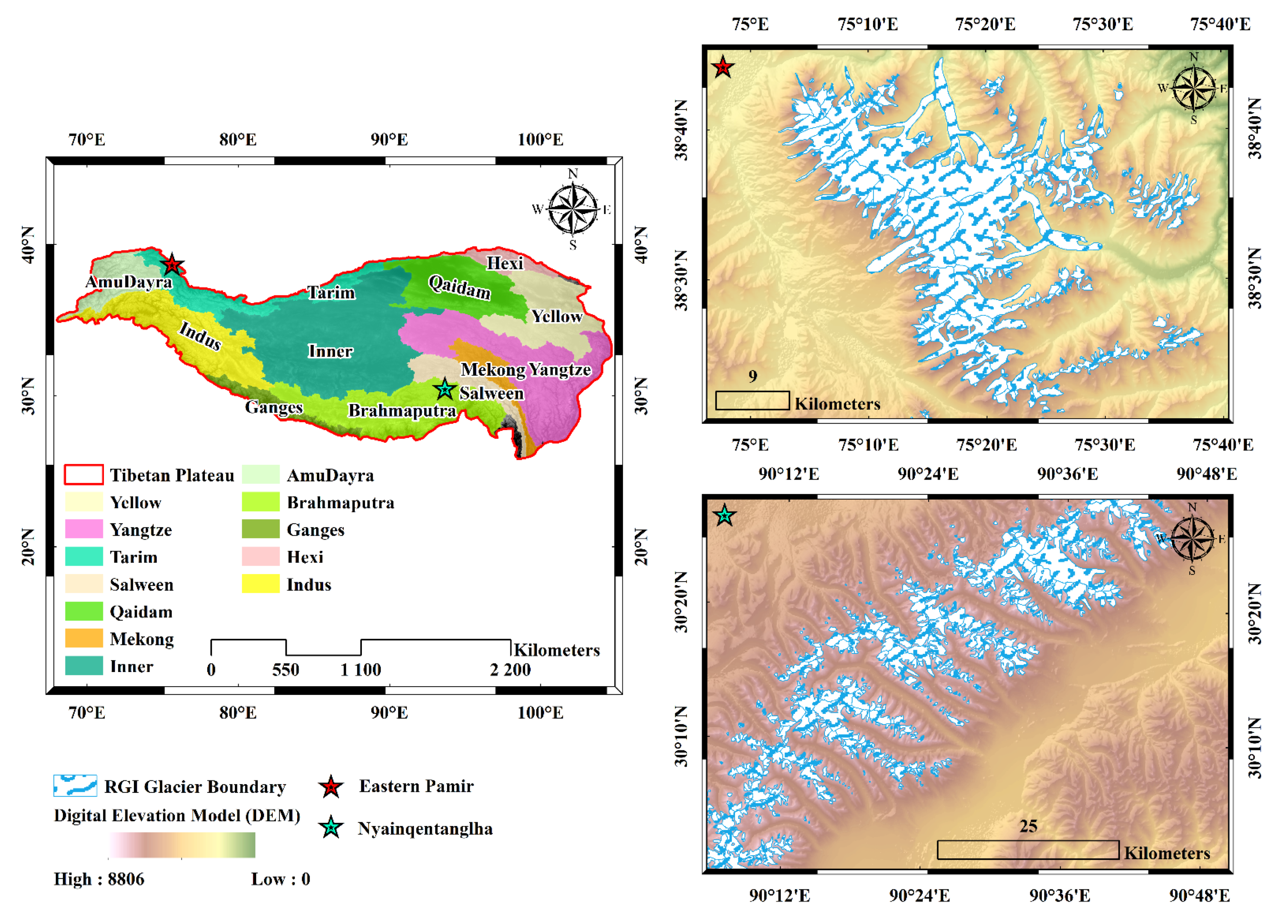
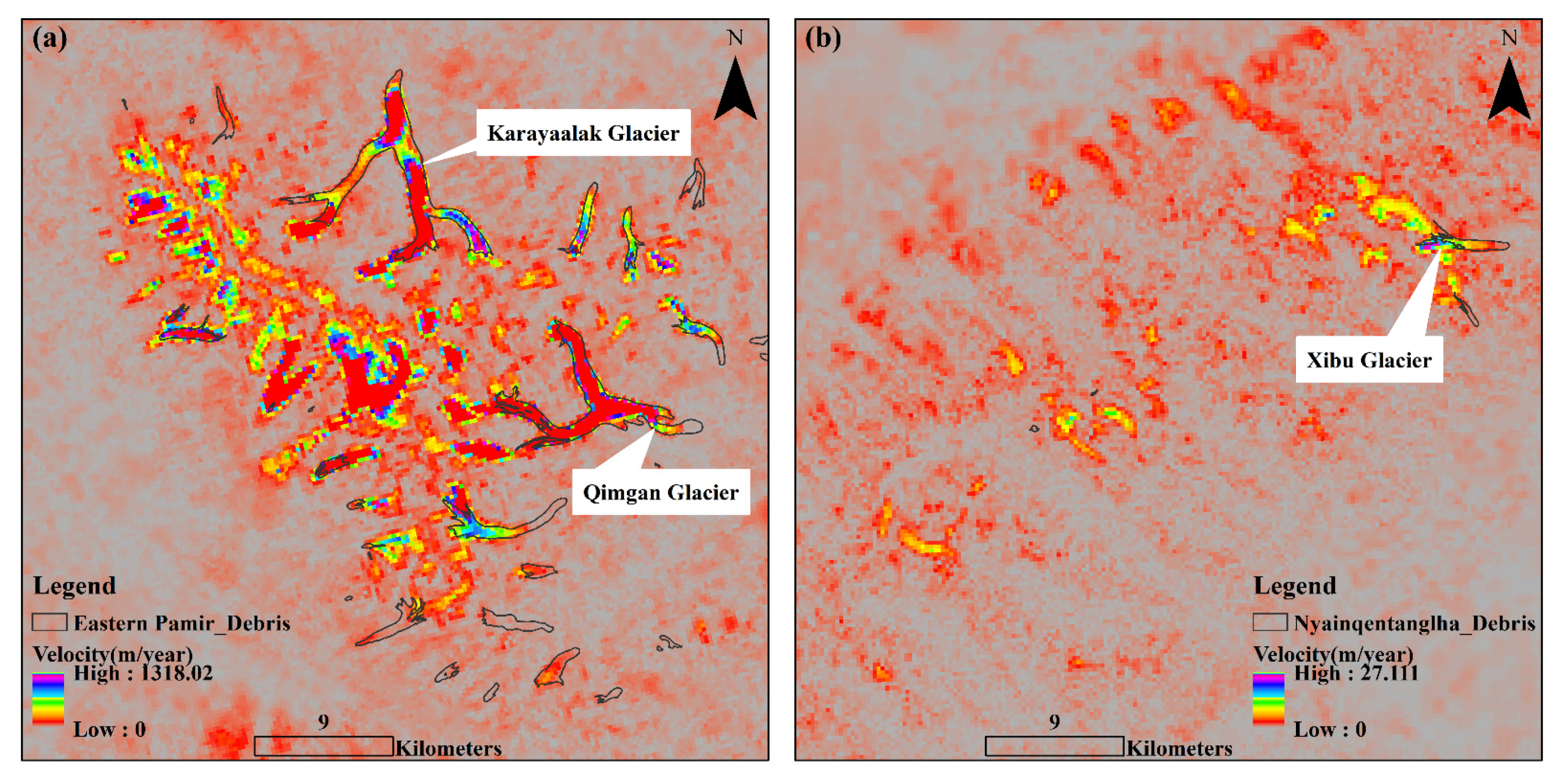
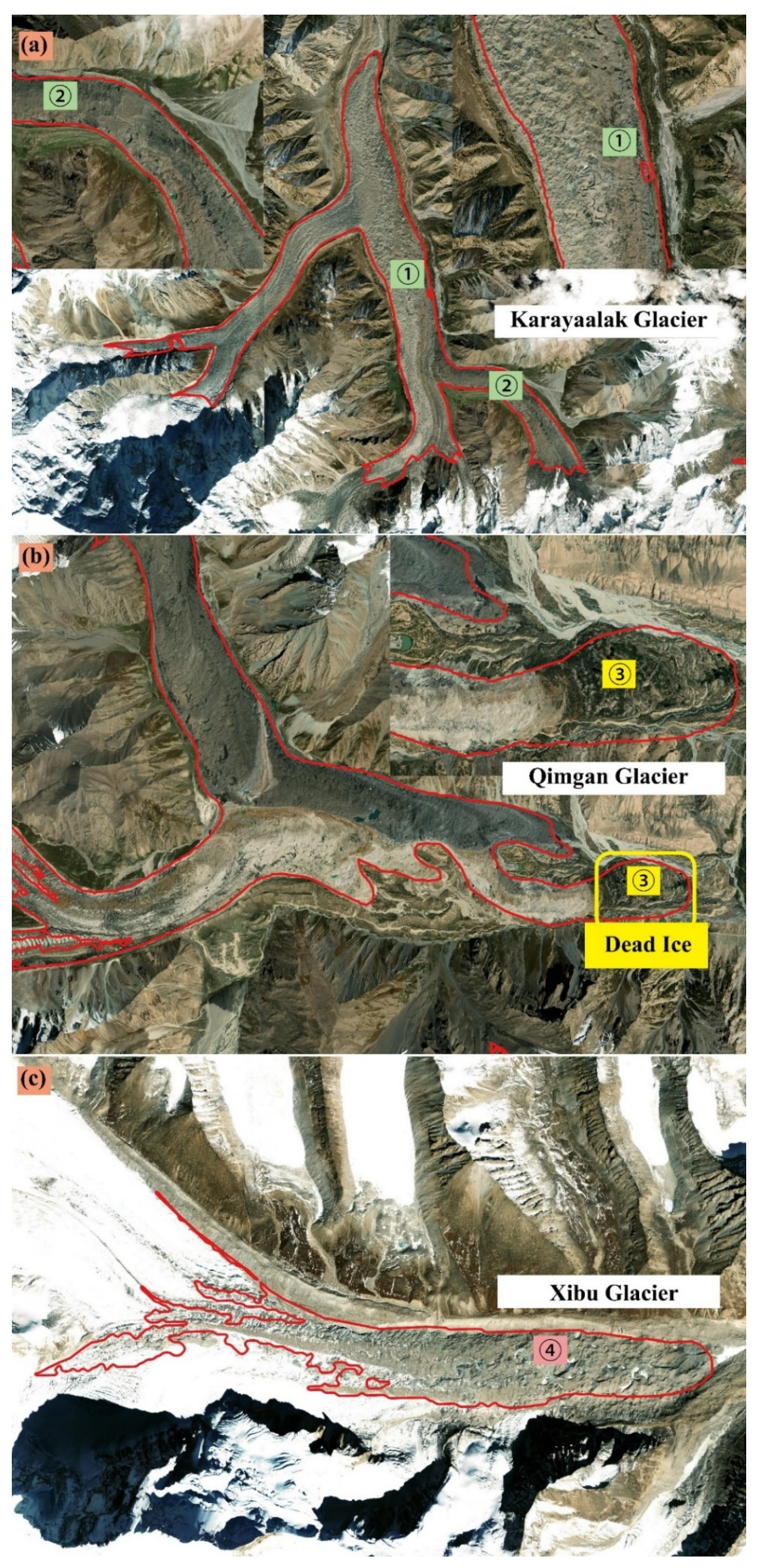
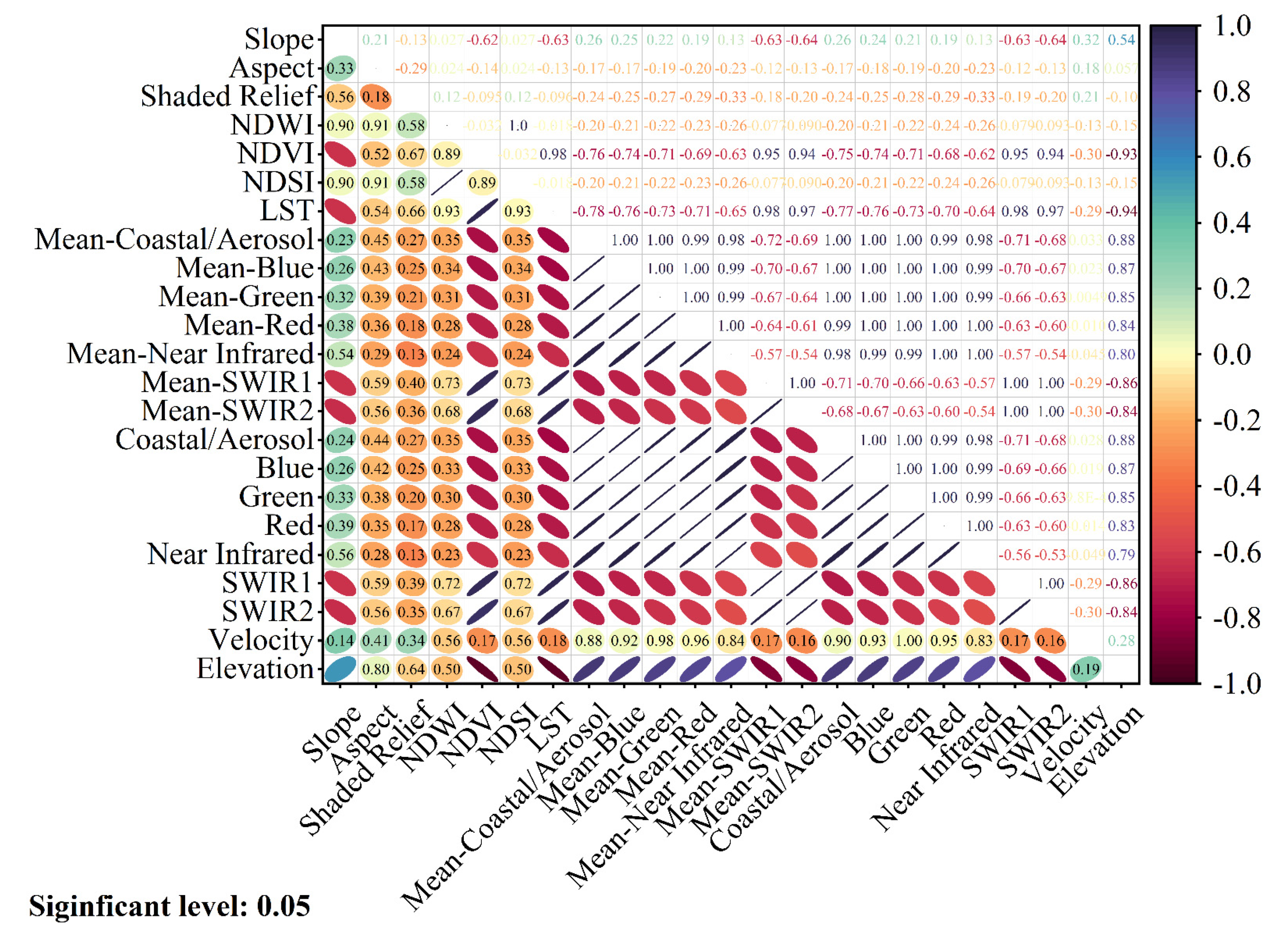
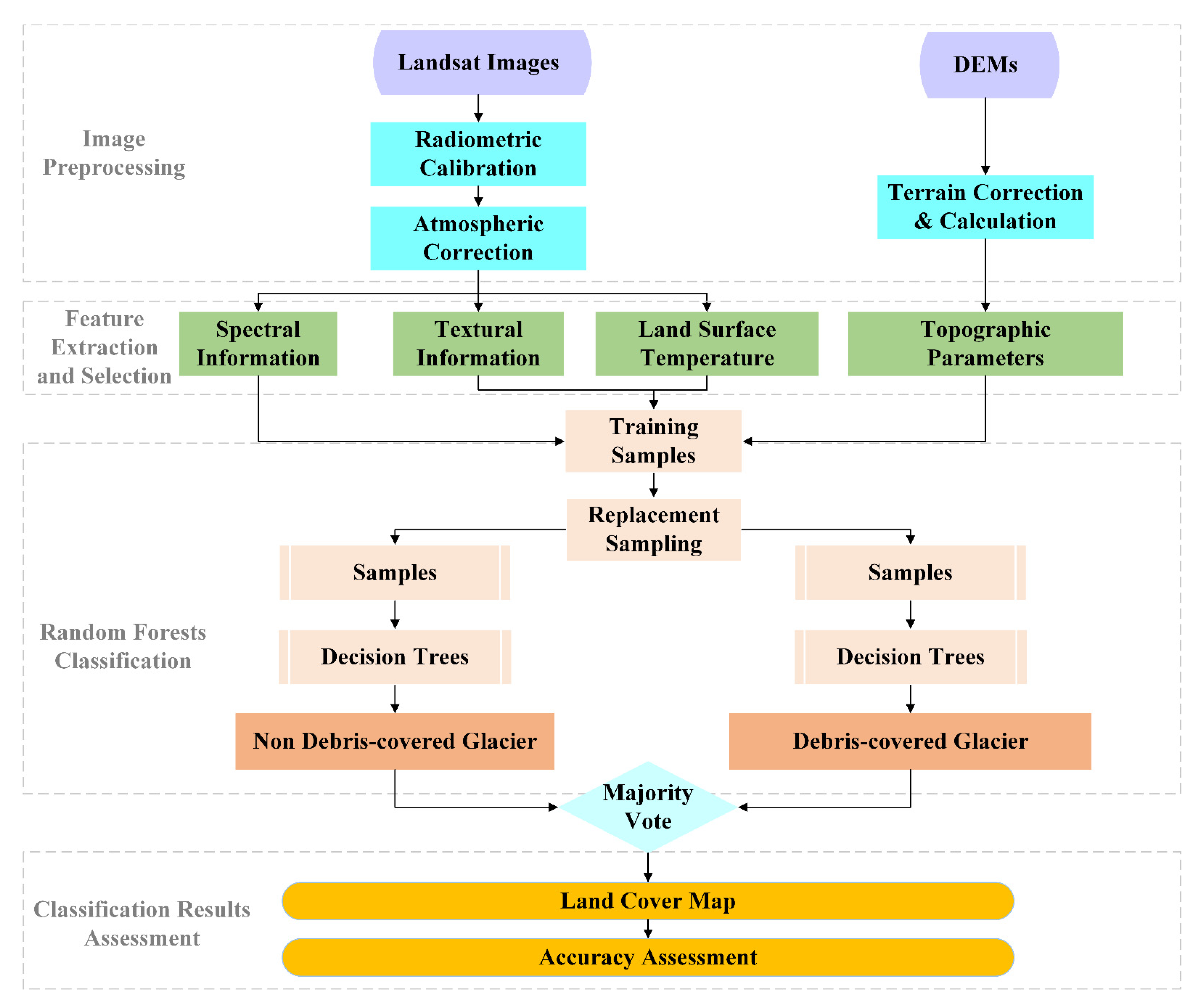
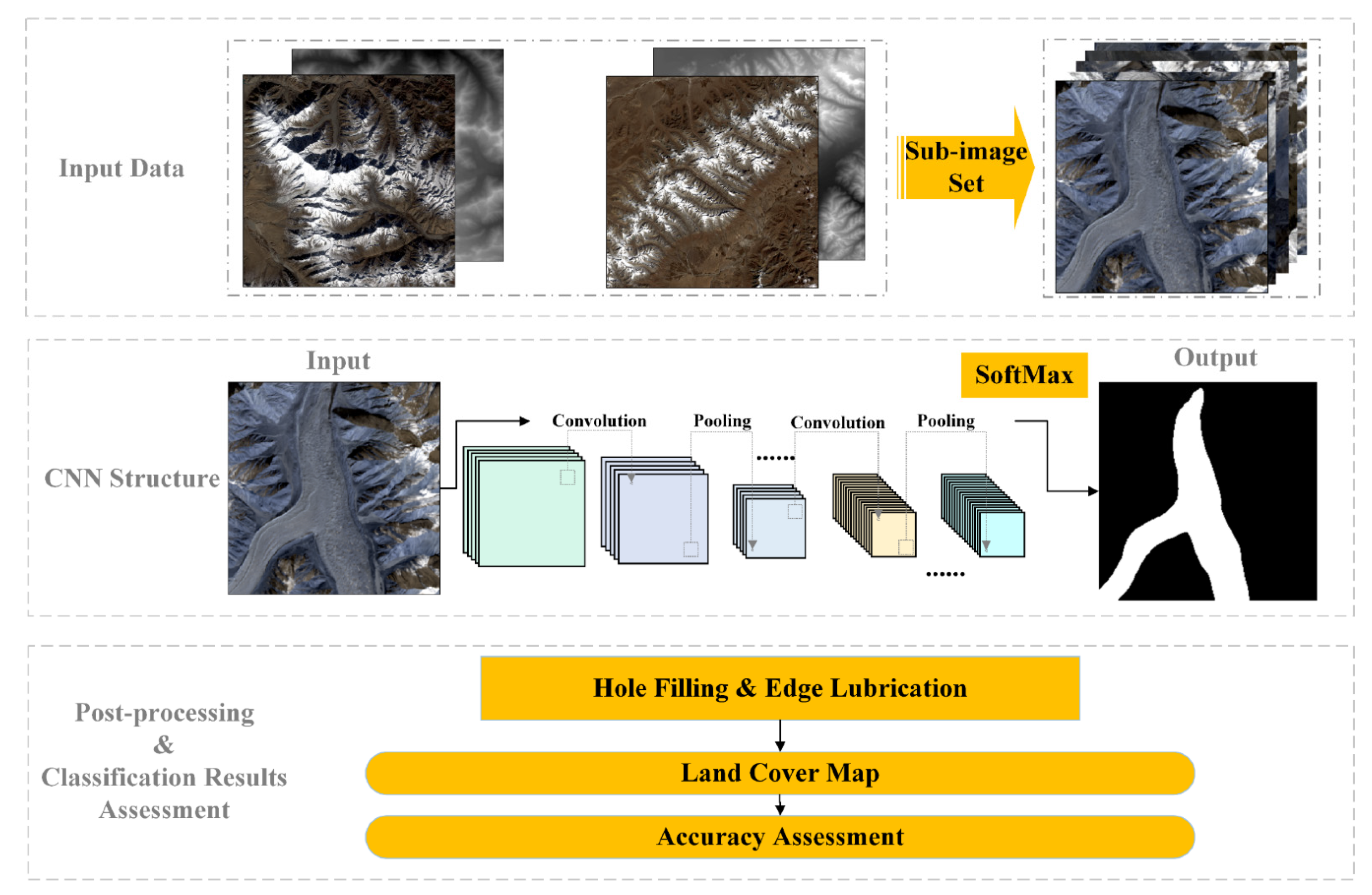
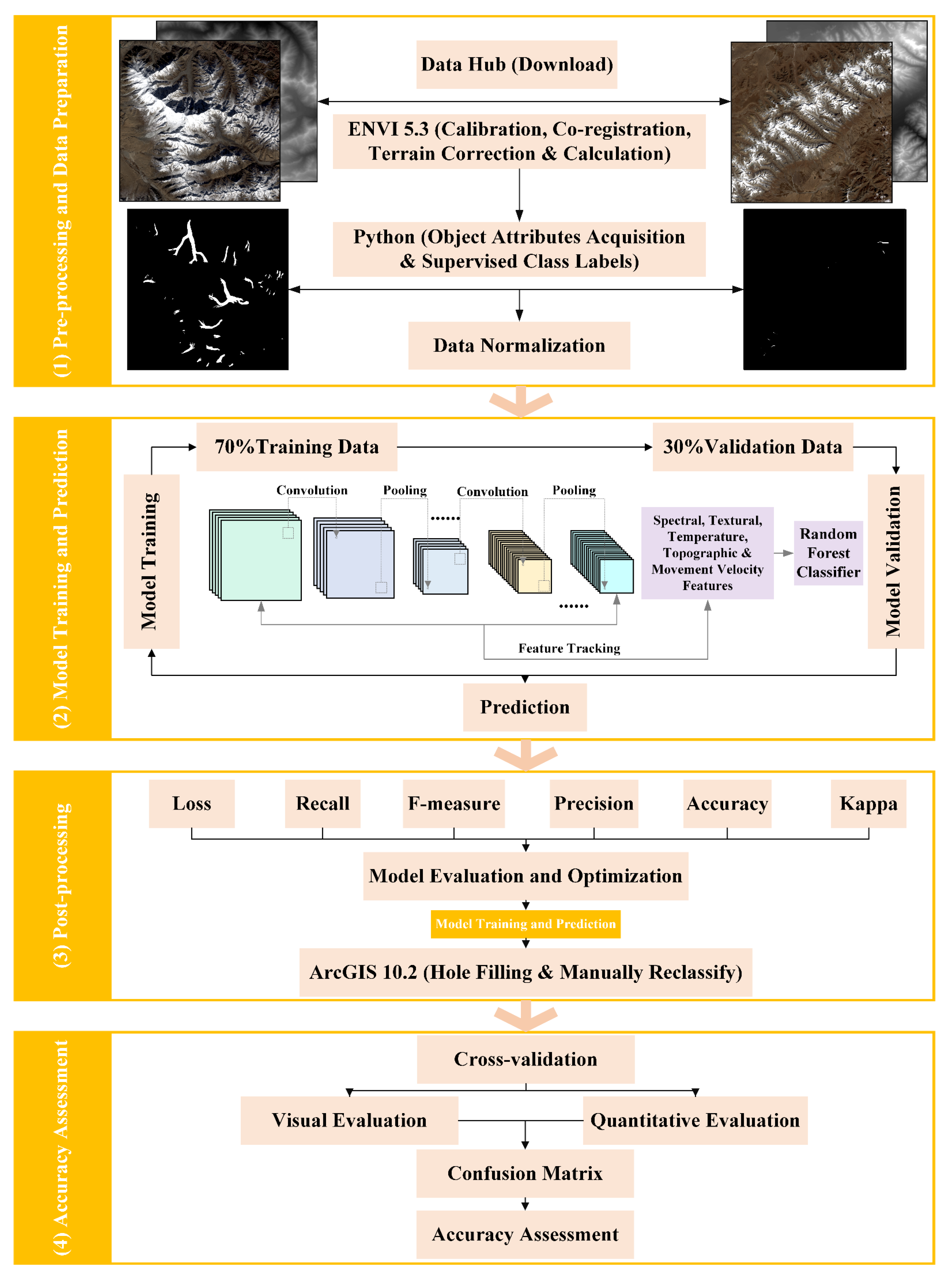
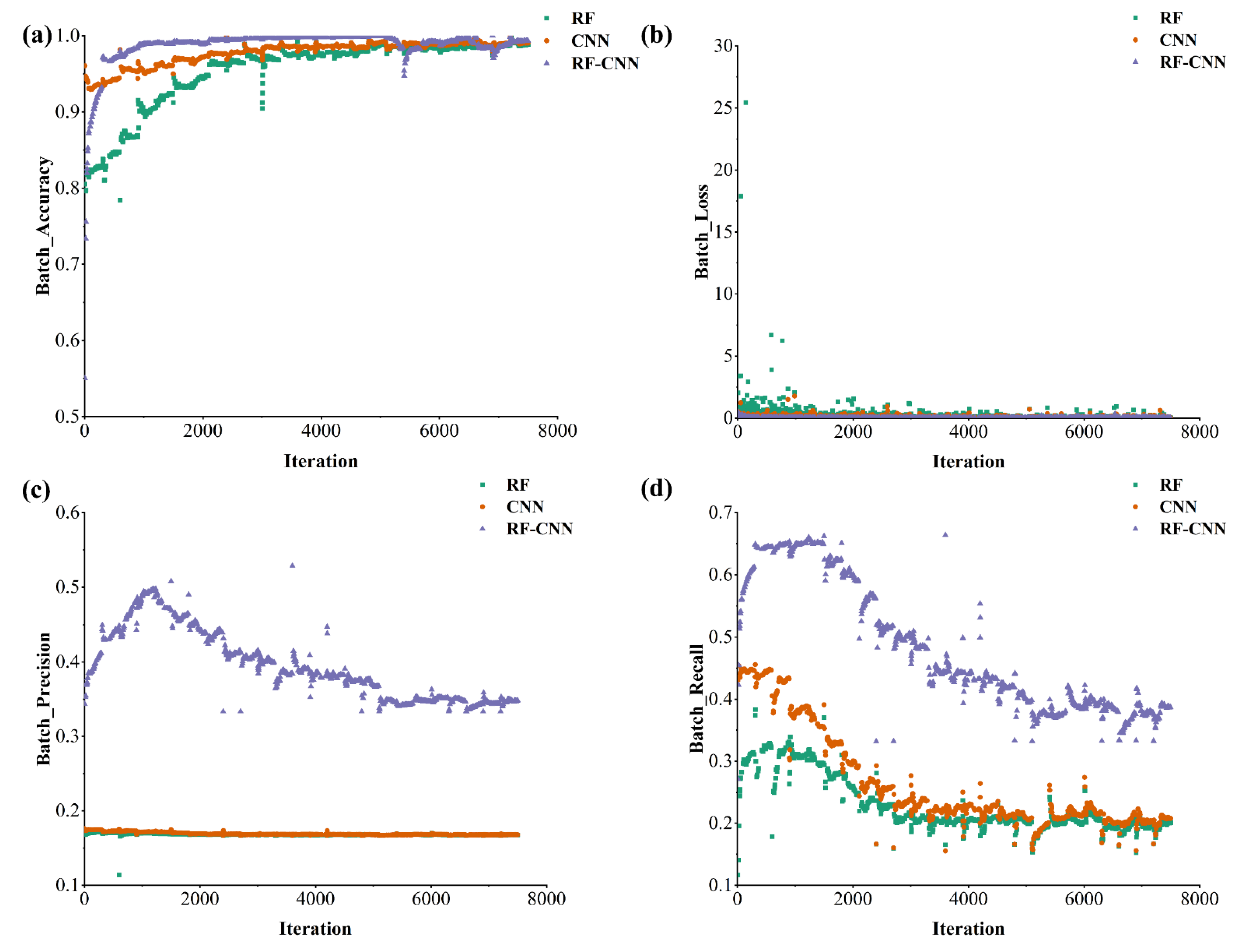
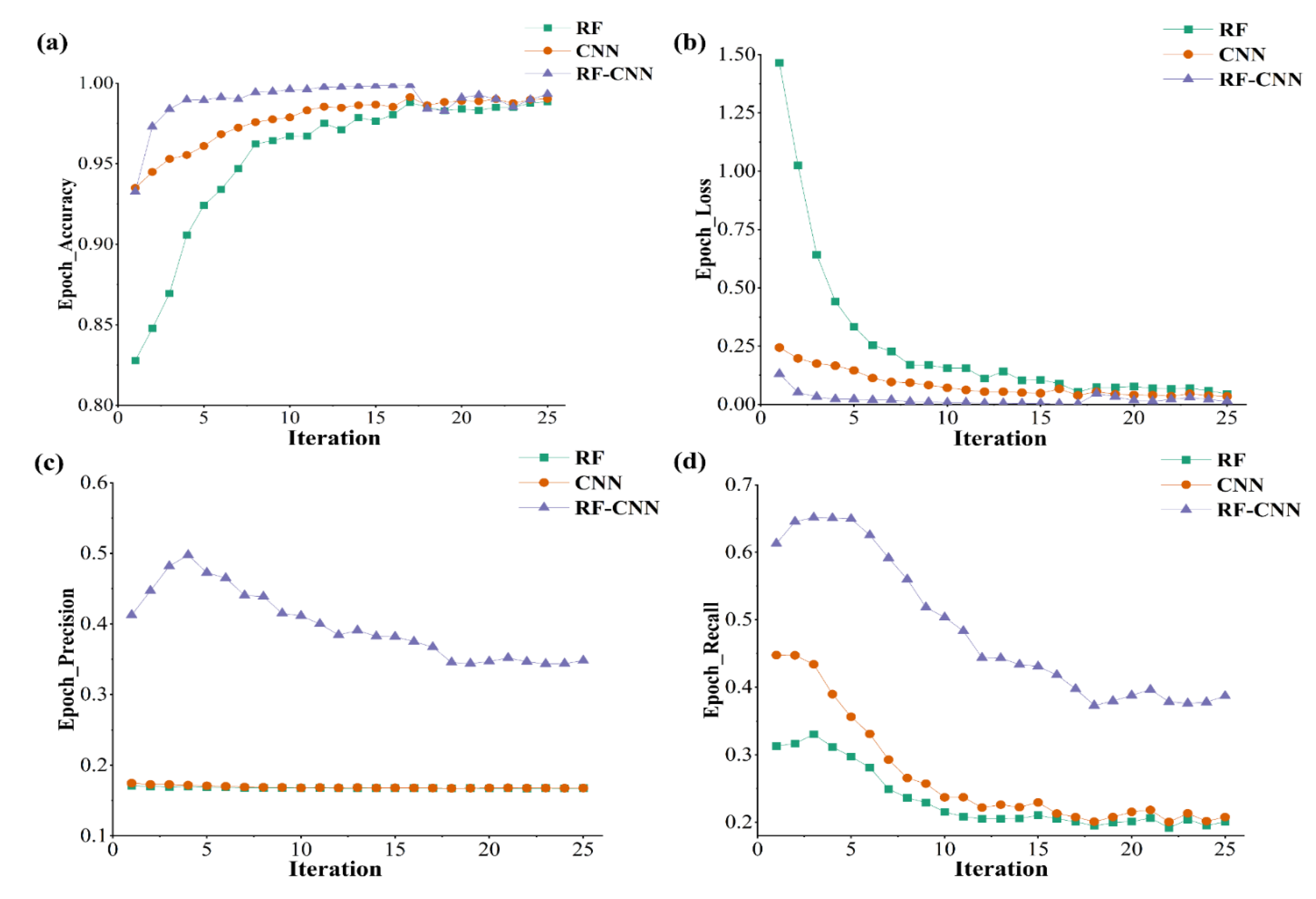
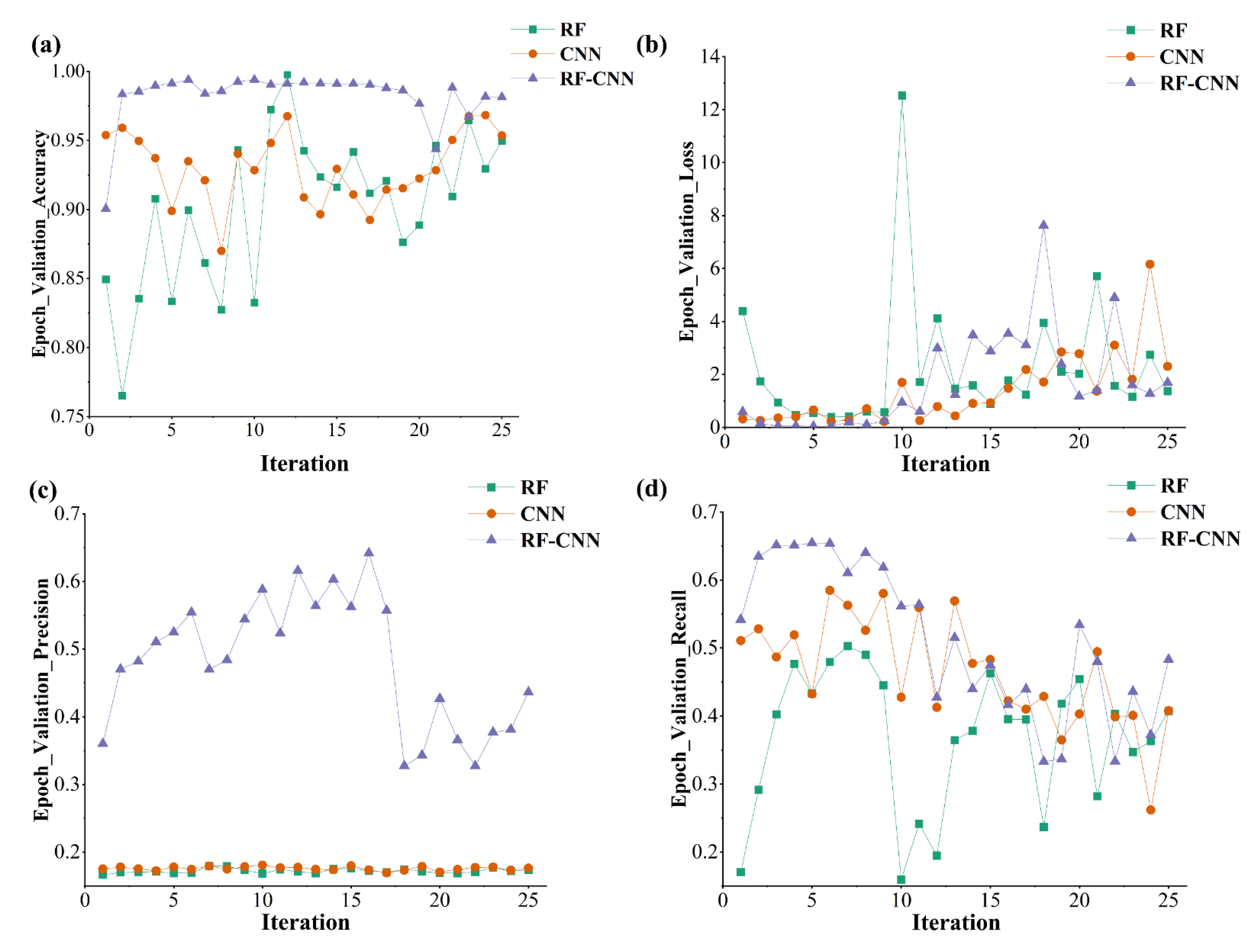
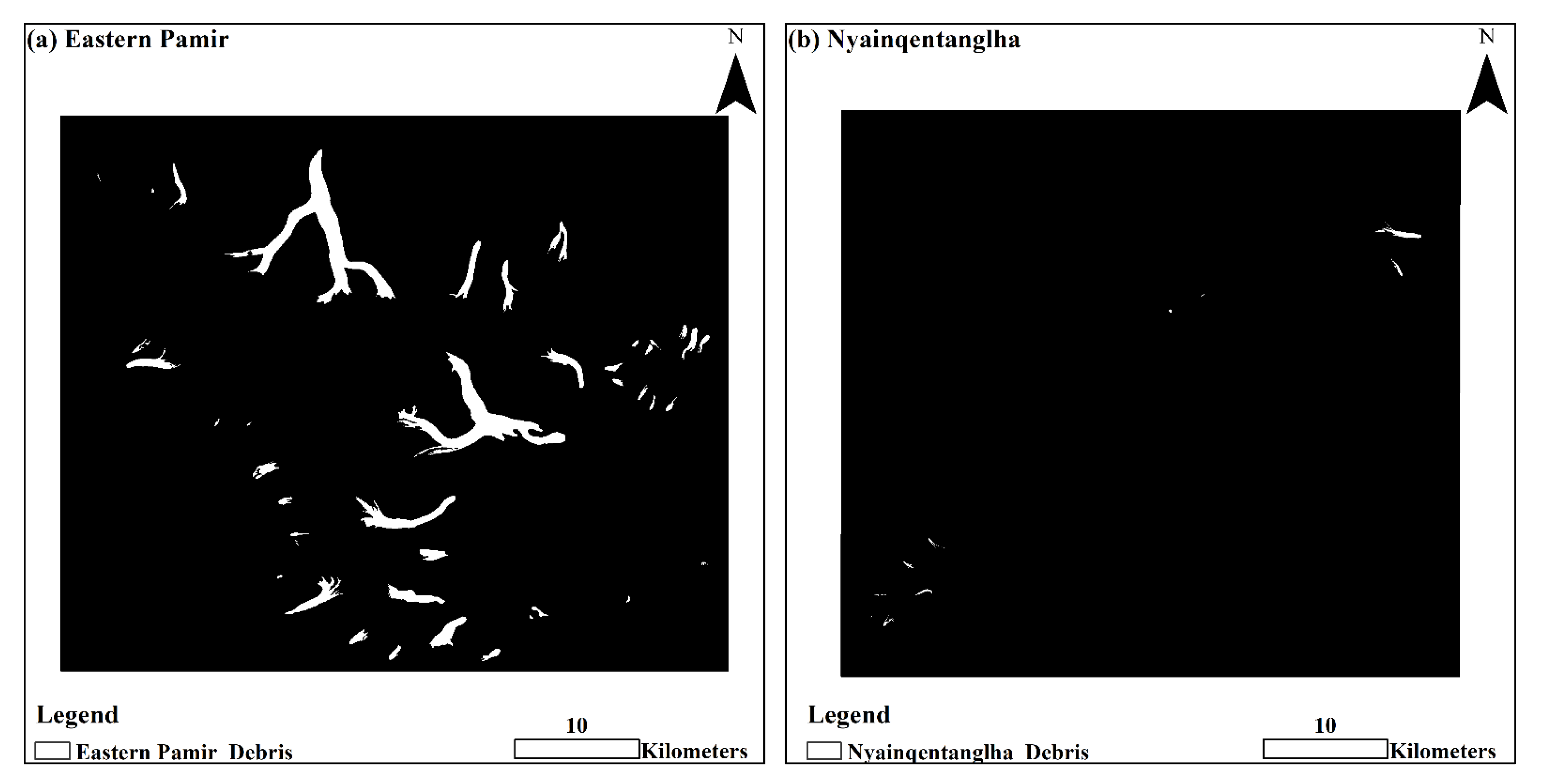
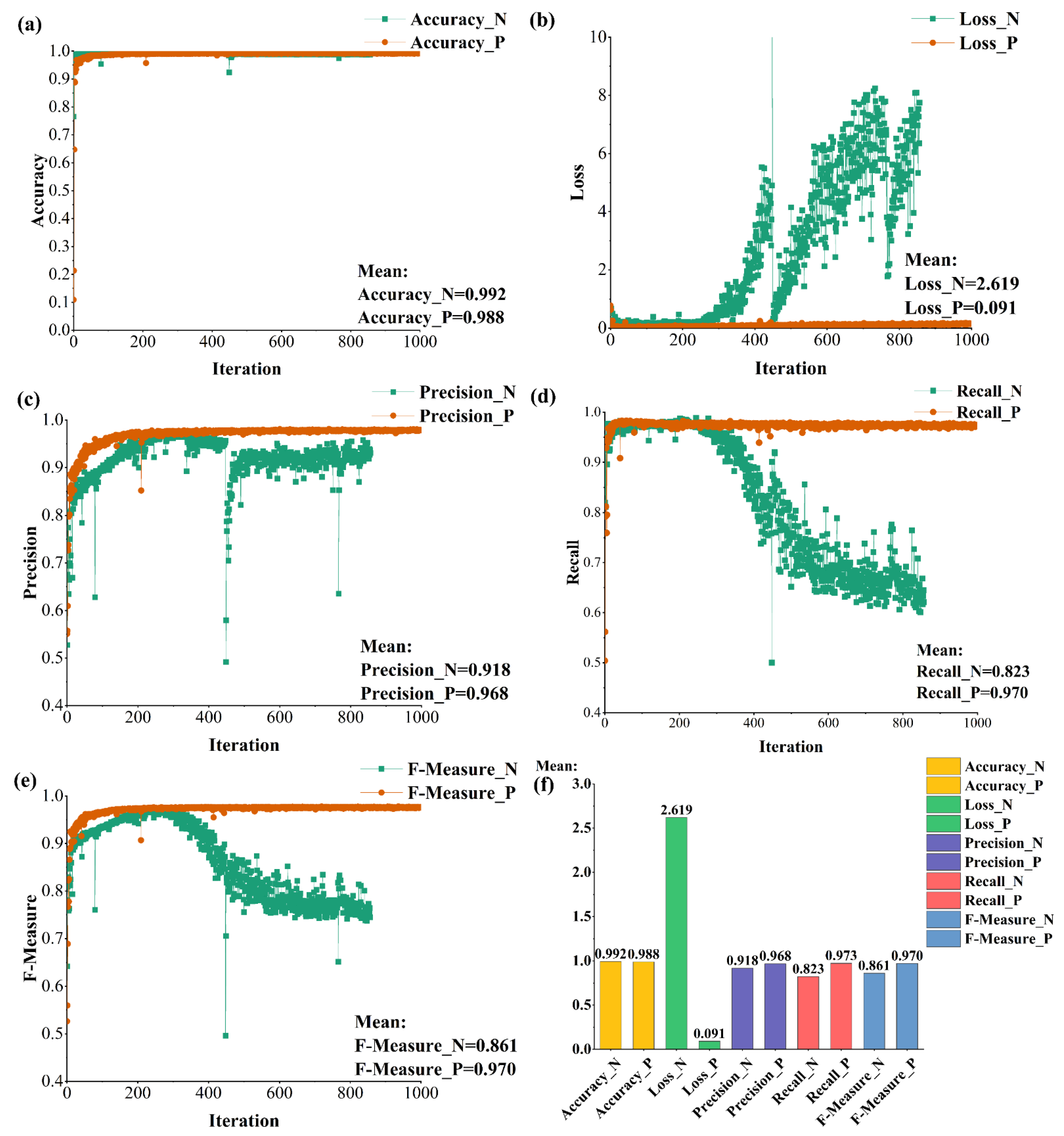
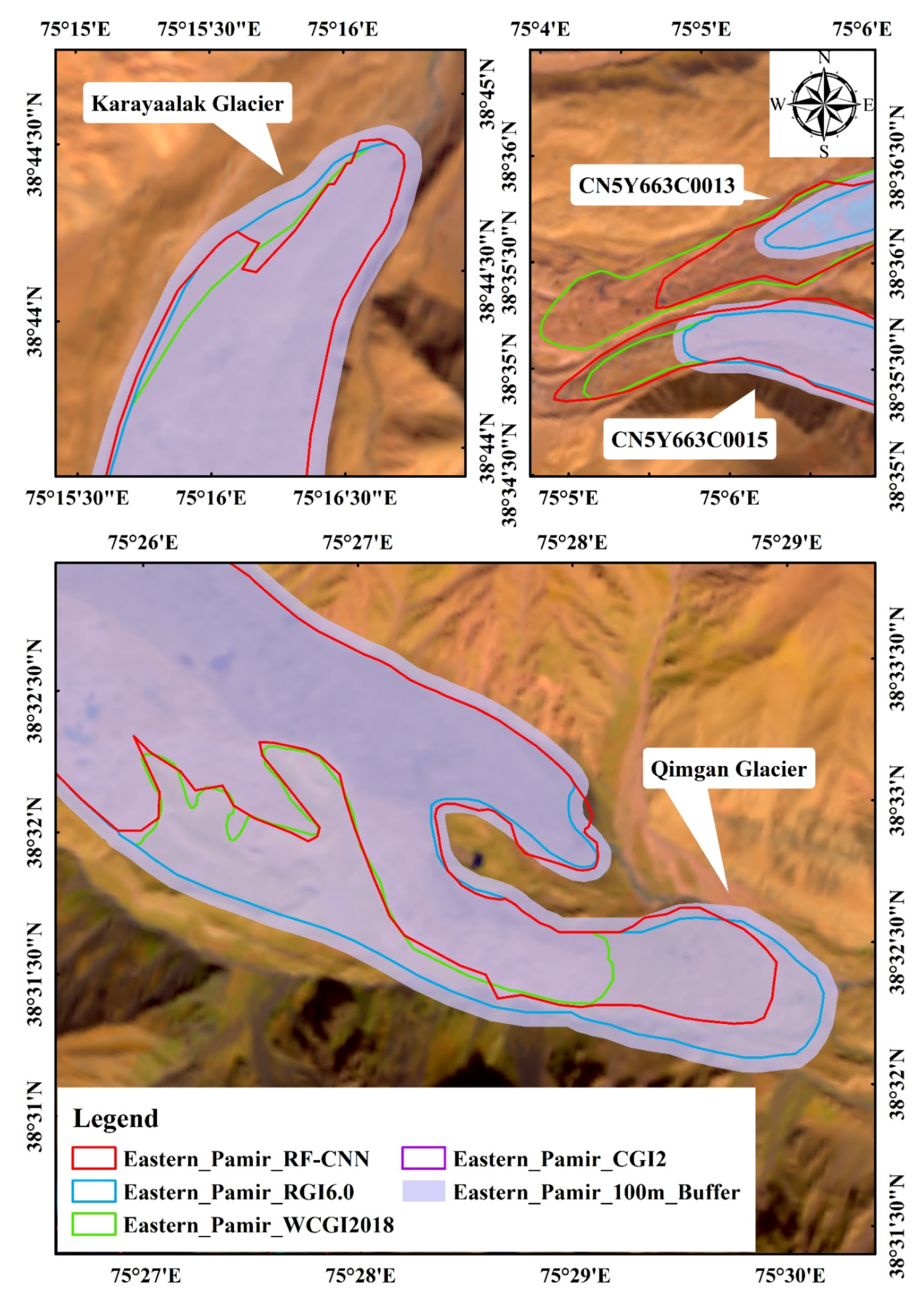
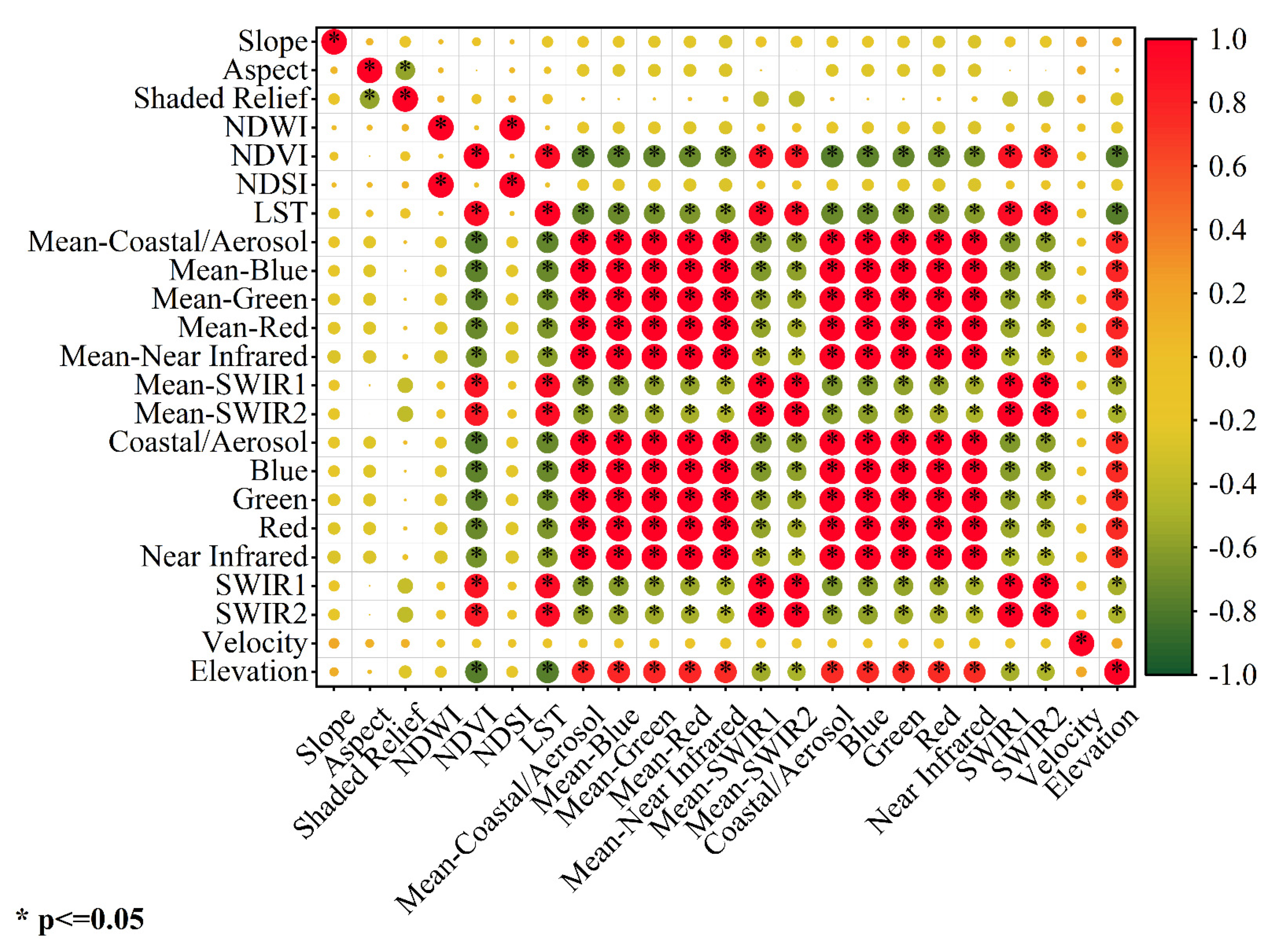
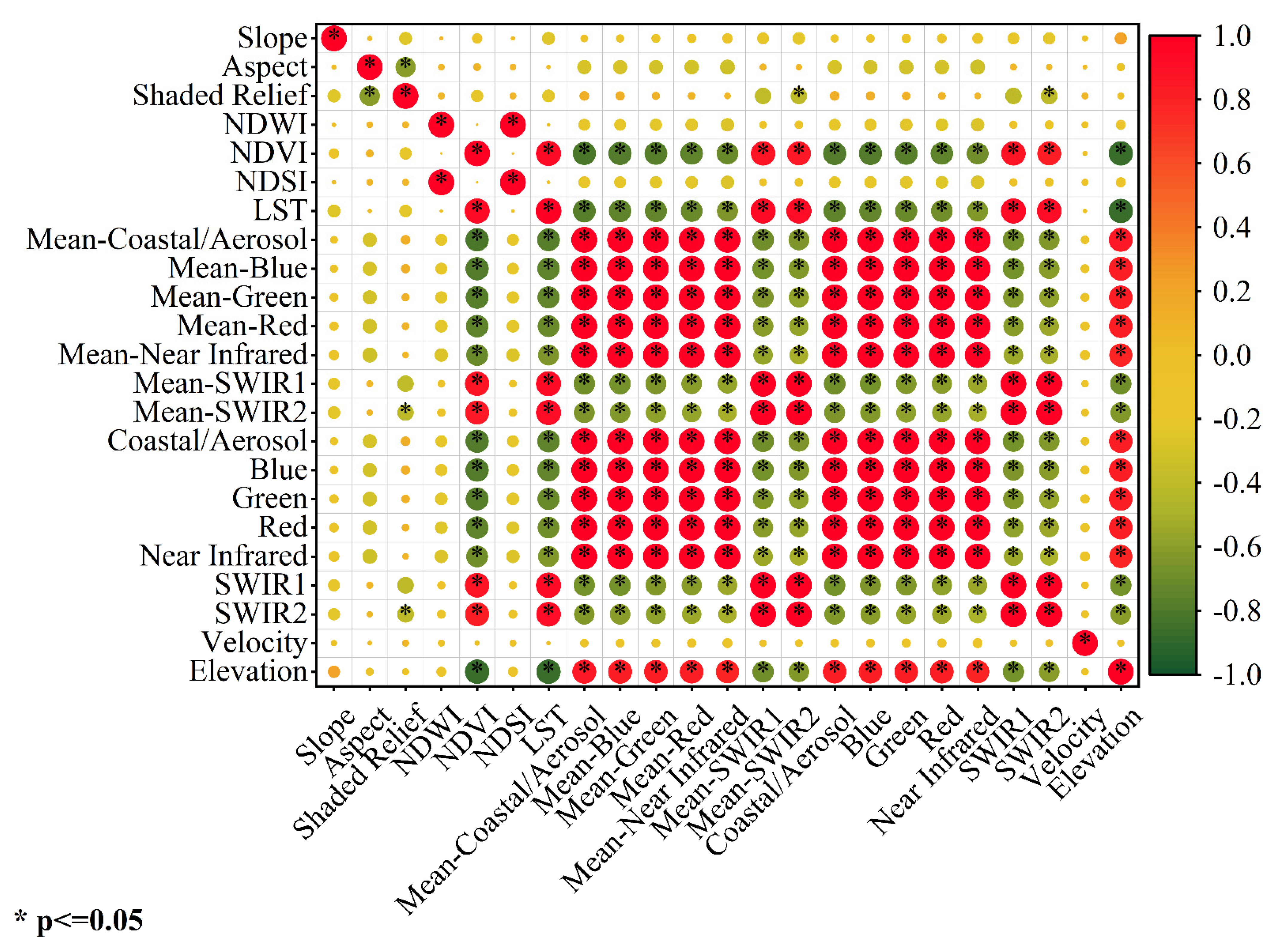
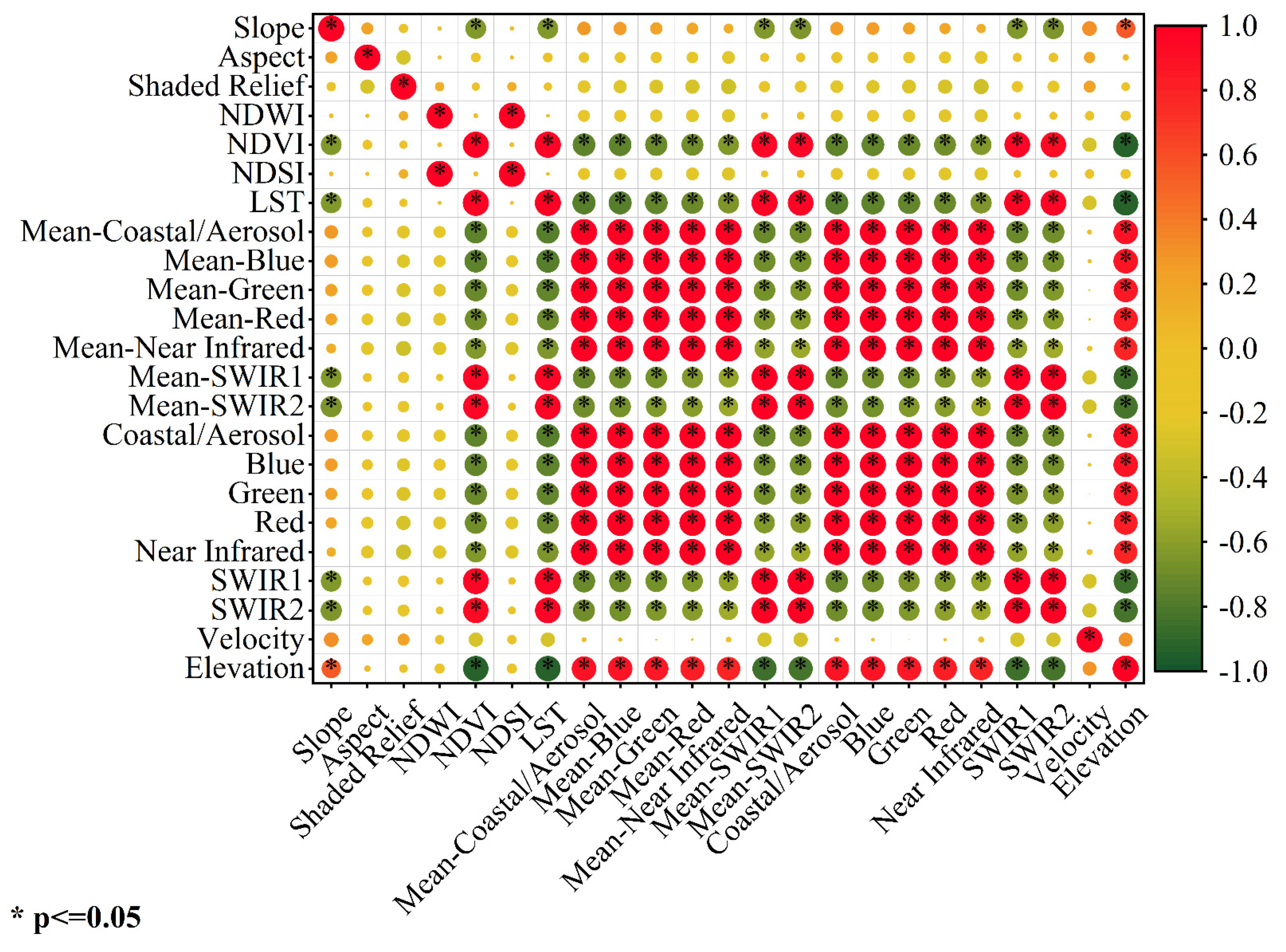
| Data | Acquisition Time (YearMonthDay) | Bands | Resolution (m) |
|---|---|---|---|
| Landsat 8 | Eastern Pamir 20171020 | OLI (B1, B2, B3, B4, B5, B6, and B7) | 30 |
| Nyainqentanglha 20171023 | |||
| Landsat 8 | Eastern Pamir 20171020 | TIRS (B10) | 100 |
| Nyainqentanglha 20171023 | |||
| ASTER GDEM V2 | 2009 | Estimation of terrain elevation | 30 |
| The Randolph Glacier Inventory: Version 6.0 (RGI 6.0) | 2017 | Estimation of glacier area change | |
| The second glacier inventory dataset of China (CGI2) | 2006–2011 | Estimation of glacier area change | |
| A dataset of glacier inventory of West China in 2018 (WCGI) | 2018 | Estimation of glacier area change |
| Name | Explanation | Value |
|---|---|---|
| N_estimators | Maximum number of weak learners (decision trees). | 1000 |
| Criterion | Criteria for evaluating features when dividing decision trees. The options are ‘Gini’ for Gini impurities and ‘entropy’ for information gain. | Gini |
| Max_features | Maximum number of features considered when dividing decision trees. | None |
| Max_depth | Decision tree maximum depth. | None |
| Min_samples_split | Minimum number of samples required for internal node subdivision. | 10 |
| Min_samples_leaf | Minimum number of samples for leaf nodes. | 1 |
| Training Threshold Contribution | Determines the contribution of internal weights related to the activation node level. | 0.9 |
| Training Rate | The larger the parameter value, the faster the training. speed, but it also increases the swing or causes the training result to not converge. | 0.2 |
| Training Momentum | The function of this parameter is to cause the weight to change in the current direction. | 0.9 |
| Training RMS Exit Criteria | At this specific value of RMS error, the training should stop. | 0.1 |
| Number of Hidden Layers | The number of hidden layers used. | 1 |
| Number of Training Iterations | The number of iterations used for training. | 1000 |
| Confusion Matrix | Prediction | ||
|---|---|---|---|
| 1 | 0 | ||
| Real | 1 | TP | FN |
| 0 | FP | TN | |
| Measure Name | Formula |
|---|---|
| Recall | |
| Precision | |
| Accuracy | |
| F-measure | |
| Kappa |
| Eastern Pamir | RF | CNN | RF-CNN |
|---|---|---|---|
| Overall Accuracy | 97.60% | 96.34% | 98.14% |
| Kappa Coefficient | 0.96 | 0.95 | 0.97 |
| User’s Accuracy | 91.59% | 87.96% | 97.90% |
| Producer’s Accuracy | 97.17% | 98.69% | 98.33% |
| Nyainqentanglha | |||
| Overall Accuracy | 99.31% | 99.06% | 97.62% |
| Kappa Coefficient | 0.98 | 0.97 | 0.94 |
| User’s Accuracy | 92.53% | 78.75% | 90.60% |
| Producer’s Accuracy | 98.86% | 97.53% | 74.54% |
| Glacier Name | Existing Methods and Inventories (km2) | |||||
|---|---|---|---|---|---|---|
| RGI 6.0 | CGI 2 | WCGI 2018 | STD. | Mean | RF-CNN | |
| G075254E38623N | 115.162 | 115.162 | 114.833 | 0.155 | 115.052 | 115.588 |
| G075133E38690N | 11.557 | 11.557 | 11.481 | 0.036 | 11.532 | 11.699 |
| G075146E38607N | 17.207 | 17.207 | 17.420 | 0.100 | 17.278 | 17.904 |
| G075262E38523N | 10.365 | 10.365 | 10.599 | 0.110 | 10.443 | 10.846 |
| G075400E38636N | 9.934 | 9.934 | 9.853 | 0.038 | 9.907 | 9.934 |
| G075339E38560N | 86.631 | 86.631 | 83.998 | 1.241 | 85.753 | 84.859 |
| G075304E38449N | 22.950 | 22.950 | 22.914 | 0.017 | 22.938 | 23.192 |
| G075321E38480N | 26.468 | 26.468 | 26.468 | 0 | 26.468 | 26.469 |
| G075457E38631N | 13.901 | 13.901 | 13.882 | 0.009 | 13.895 | 13.930 |
| G075486E38594N | 9.346 | 9.346 | 9.464 | 0.056 | 9.385 | 9.519 |
| G090600E30388N | 27.354 | 27.354 | 27.298 | 0.026 | 27.335 | 27.417 |
| G090618E30355N | 7.133 | 7.133 | 7.105 | 0.013 | 7.124 | 7.229 |
| G090071E29968N | 4.762 | 4.762 | 4.668 | 0.044 | 4.731 | 4.672 |
| G090039E29949N | 3.048 | 3.048 | 2.943 | 0.049 | 3.013 | 3.051 |
| G090040E29912N | 5.444 | 5.444 | 5.438 | 0.003 | 5.442 | 5.717 |
Publisher’s Note: MDPI stays neutral with regard to jurisdictional claims in published maps and institutional affiliations. |
© 2021 by the authors. Licensee MDPI, Basel, Switzerland. This article is an open access article distributed under the terms and conditions of the Creative Commons Attribution (CC BY) license (https://creativecommons.org/licenses/by/4.0/).
Share and Cite
Lu, Y.; Zhang, Z.; Shangguan, D.; Yang, J. Novel Machine Learning Method Integrating Ensemble Learning and Deep Learning for Mapping Debris-Covered Glaciers. Remote Sens. 2021, 13, 2595. https://doi.org/10.3390/rs13132595
Lu Y, Zhang Z, Shangguan D, Yang J. Novel Machine Learning Method Integrating Ensemble Learning and Deep Learning for Mapping Debris-Covered Glaciers. Remote Sensing. 2021; 13(13):2595. https://doi.org/10.3390/rs13132595
Chicago/Turabian StyleLu, Yijie, Zhen Zhang, Donghui Shangguan, and Junhua Yang. 2021. "Novel Machine Learning Method Integrating Ensemble Learning and Deep Learning for Mapping Debris-Covered Glaciers" Remote Sensing 13, no. 13: 2595. https://doi.org/10.3390/rs13132595
APA StyleLu, Y., Zhang, Z., Shangguan, D., & Yang, J. (2021). Novel Machine Learning Method Integrating Ensemble Learning and Deep Learning for Mapping Debris-Covered Glaciers. Remote Sensing, 13(13), 2595. https://doi.org/10.3390/rs13132595





